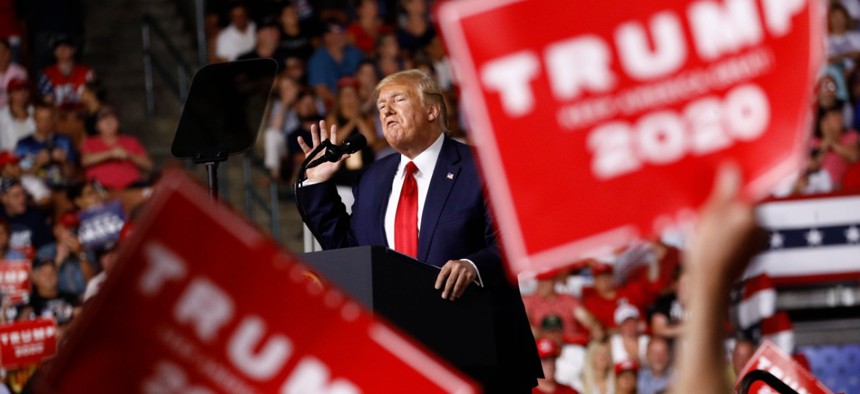
Patrick Semansky/AP
One Thing About the 2020 Election Is Already Clear
Regardless of which side wins next year, the divide between red and blue America is likely to only grow wider.
The 2020 presidential election remains very much up for grabs, but one thing already seems clear: It will end with about half of America triumphant, and the other half furious and fearful.
Whichever side ultimately prevails in November, red and blue America are diverging along both demographic and geographic lines as sharply as at any other point in modern American history. The biggest lesson of the coming year may be that for all the divisiveness that President Donald Trump has stoked, the political divide may still continue to grow wider.
The 2020 election looms as a “Battle of the Bulge” between a Republican coalition that represents what America has been and a Democratic coalition that embodies what it is becoming. By all indications, turnout in next year’s election is poised to be the highest in decades, in part because so many Americans consider the stakes to be so high. Across the red and blue divide, it is now common to hear voters say that they fear the America they believe in will disappear if the other side prevails in 2020. That anxiety and antagonism have been building for years, but they have dramatically intensified since 2016.
Trump is the first president since at least the Civil War to so directly kindle the nation’s political conflicts. He has governed almost entirely as the president of red America, excoriating his political opponents while wielding the power of the federal government to punish blue America. He has been unique among presidents in offering virtually no concessions to viewpoints outside of his coalition.
These actions are accelerating what’s been a long-standing political separation. After the 2012 election, I wrote that the main dividing line between the parties had become attitudes toward the cultural, demographic, and even economic trends transforming the nation. Democrats now mobilize a “coalition of transformation” centered on the younger, nonwhite, and college-educated white voters comfortable with these changes—most of whom are clustered in the nation’s largest metropolitan areas. Republicans, in turn, rely on a “coalition of restoration” centered on groups of voters who feel most uneasy about, and even threatened by, these changes: disproportionately older, non-college-educated, and evangelical whites who live outside of metropolitan centers.
That separation only intensified in the 2016 presidential election. Hillary Clinton won 87 of the nation’s 100 largest counties by a combined margin of nearly 15 million votes, according to calculations by the Pew Research Center, but Trump won over 2,400 of the remaining 3,000 counties and a higher total number of counties than any other nominee in either party had captured since Ronald Reagan’s blowout in 1984. The 2018 midterm elections further deepened that chasm, with Democrats consolidating their hold on the nation’s largest metropolitan areas in House and Senate races but failing to materially dent the Republican dominance beyond them.
On the whole, polls suggest that the 2020 election will closely track 2016, with small changes among key groups potentially tipping the result. Democrats hope that revulsion at Trump’s behavior will help them make gains with traditionally Republican-leaning blue-collar white women and college-educated white men, and further boost their margins with college-educated white women who have left the GOP in droves. Republicans believe that the strong economy and Trump’s swaggering style will lead them to make small gains with Hispanic and African American men, suppress any defections from the working-class white women who backed him in 2016, and prompt greater turnout among the party’s base.
Trump’s persistently low approval rating—he is the only president in the history of Gallup polling never to crack 50 percent at any point in his tenure—means he faces an uphill climb to win the popular vote. But he could still squeeze out another Electoral College victory without it. Like in 2016, the election will likely hinge on just a few states that could be decided by very small margins: Pennsylvania and Michigan, which both polls and the 2018 election results suggest lean slightly toward the Democrats; Florida and North Carolina, which lean toward Trump; and Wisconsin and Arizona, which sit precariously at the absolute tipping point between both parties.
It’s this combination of factors that makes American politics so uniquely volatile at this moment. The country is deeply divided between two equally matched coalitions: Neither side has been able to establish a durable advantage over the other for the past half century. Since 1968, one party has simultaneously controlled the White House, the House, and the Senate for only 14 years. The past four times a president went into a midterm election with unified control of government, most recently Trump in 2018, voters revoked it. Neither Democrats nor Republicans can truly be confident about the outcome of the presidential race in 2020, and while each party might be favored to hold the congressional chamber it now controls, neither advantage is impregnable.
The long-term demographic trends in the electorate—more racial diversity, more college graduates, more urbanization, more voters who aren’t Christian—benefit Democrats, but those advantages are offset by signs that those very changes are leading more white voters wary about them to back Trump. Republicans think they can squeeze out larger margins from shrinking groups; as a long-term strategy, that’s a dicey proposition. But it could prevail in the near term, especially since both the Electoral College and the Senate benefit small states that remain mostly white and Christian. Amid such closely balanced contending forces, both parties live in constant fear that even the tiniest of blunders will lead to victory for the other.
That the parties are growing in their differences only compounds that fear. Election outcomes now produce whiplash-inducing reversals in policy outcomes, since the two sides represent coalitions with such divergent priorities and preferences. Polling by the nonpartisan Public Religion Research Institute captured that separation: In an October survey, 92 percent of voters who approved of Trump said Republicans are working “to protect the American way of life against outside threats,” while 75 percent of voters who disapproved of him said the GOP has been taken over by racists. Conversely, three-fourths of Trump approvers said Democrats have been taken over by socialists, while three-fourths of those who disapproved of him said the Democratic Party is endeavoring to make capitalism work better for average Americans.
Separate polling from Pew has found that Democrats and Republicans hold views of the other that are growing more negative, with GOP partisans especially likely to view Democrats as immoral and unpatriotic. While most Democrats in the Pew poll indicated that they would prefer their party to seek common ground with the other, most Republicans did not—attitudes that explain both the appeal to Democratic voters of former Vice President Joe Biden’s promise to seek bipartisan cooperation if elected and the widespread skepticism among leaders in both parties that he’s likely to obtain it.
These underlying trends will endure whichever side wins control of the White House and Congress next year. The relentless geographic and demographic sorting of the parties means that the two coalitions more and more inhabit separate realities: Nationally, Clinton beat Trump in the 2016 popular vote by a little over two percentage points, but 60 percent of Americans lived in counties that were decided by 20 points or more, according to calculations by Bill Bishop, the author of The Big Sort. (That was up from just one-fourth of Americans living in such landslide counties in 1976 and half as recently as 2012.) It’s possible, maybe even likely, that this divide will widen in 2020, with diverse major metropolitan areas rejecting Trump by even larger margins than in 2016, while predominantly white, rural areas rally behind him more firmly.
The outcome of the 2020 election will have enormous consequences on many fronts, but beyond all the immediate implications, it’s likely to stand as a milestone in the country’s long-term separation. The racial, religious, class, generational, and geographic trench between the parties may look even more impassable after November than it does today. Each party is understandably focused on ensuring that its side of the political divide turns out in slightly greater numbers than the other side, but the growth of the divide itself may be the dominant dynamic shaping American politics in the years ahead.







